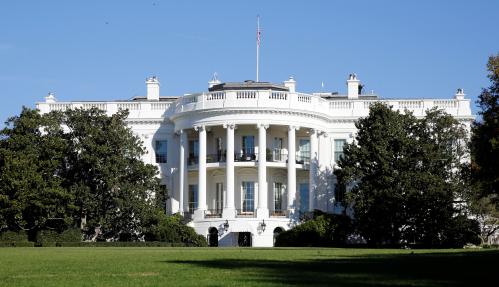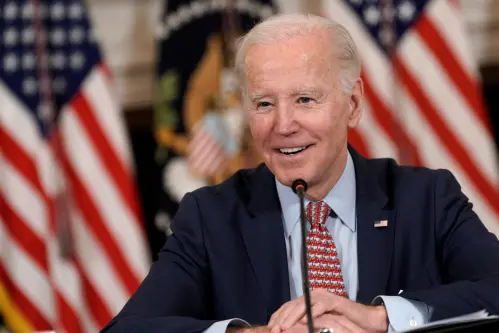This post is part of a series on the need for government reform and how to get it done. For more on this topic, visit the series page.
Joe Biden and Donald Trump have both promised very major government reform. For his part, Trump rarely misses an opportunity to reprise his past promises to drain the swamp; eliminate the fraud, waste, and abuse hidden in the federal budget; cut spending by simply buying things for less; and destroy the “deep-state” of liberal bureaucrats who are plotting his overthrow.
For his part, Biden has promised to make government work for the people again through ethics and campaign finance reform. He has also suggested that Trump’s defeat will prove to be major government reform in itself when Washington returns to bipartisanship and the regular order. “Not a joke,” Biden said in May 2019, “You will see an epiphany occur among many of my Republican friends.” Political observers, however, debate whether this idea is accurate or naïve.
Government reform is not the only item on the campaign agenda, of course. Both Trump and Biden have blended their government reform agendas with promises of a bigger government that delivers more services versus a smaller government that delivers fewer services. The combination produces four groups of reformers (referenced in the second piece in this series):
- Rebuilders who favor very major reform and a bigger government that provides more services.
- Dismantlers who favor very major reform and a smaller government that provides fewer services.
- Expanders who favor only some reform and a bigger government that provides more services.
- Streamliners who favor only some reform and a smaller government that provides fewer services.
Both candidates developed their reform agendas to favor their strongest supporters—the dismantlers for Trump and expanders for Biden. Both would gladly accept support from any quarter, but both may be courting the wrong groups as the election approaches. As Figure 1 shows, the dismantlers cannot give Trump a majority regardless of their party loyalty, while the expanders cannot give Biden a majority regardless of their commitment.[1]
All things being equal, meaning government reform is the only issue in play on Election Day, Trump must recruit the streamliners to his cause, while Biden must win a significant share of the rebuilders. All things being equal again, both candidates must also win substantial support from the other party. Scholars know that partisanship rarely yields to a specific issue such as an economic or health crisis, but every issue matters at the margins. This is why Trump’s best chance will always reside with Republican dismantlers, while Biden’s will come from Democratic rebuilders.
Figure 1
In Trump’s case, Republican dismantlers claimed a 37% share of Republican identifiers in July, followed by the streamliners at 31%, expanders at 17%, rebuilders at 14%. Assuming that party identification is nearly unbreakable, Trump must focus on the streamliners who have shown less comfort with his angry rhetoric and more confidence in government. Trump’s best option for winning the streamliners is a more temperate campaign that acknowledges the need for accommodation and principled policy—hardly an easy path given the president’s love of insult.[2]
In Biden’s case, the Democratic expanders claimed a 15% share of the party faithful in 2020 with the much more reform-minded rebuilders at 54%, the Trump-leaning dismantlers at 21 percent, and the streamliners at just 10%. In theory, Biden could win the popular vote with a combination of rebuilders and expanders, but he must find a way to merge the two without alienating the Democratic progressives represented on the left of the Biden-Sanders agenda.
Figure 2
An equally telling analysis involves a comparison of candidate support in 2016 and 2020. As Figure 2 suggests, the percentage of dismantlers has fallen since Trump’s election, while the number of expanders has remained steady. These changes suggest that public support for the four reform positions respond to the same factors that drive the demand for reform overall, most notably the potential impact of government failure.
It is possible, for example, that drop in support for dismantling and expanding is the cumulative result of the long list of post-2001 federal breakdowns and the polarized coverage that followed each one. Figures 3 and 4 shows the challenges facing each candidate as they confront the changing distribution of support between 2016 and 2020. Trump may yet find that streamliners who he has often mocked are central to his reelection, while Biden may discover that his Build Back Better agenda would be even better if he promised to fix the bureaucracy fast.
Figure 3
Biden may have the tougher challenge. Absent a firm focus on repairing the broken agencies he would inherit, the bigger programs he has touted are more likely to worry the rebuilders than entice them. Biden must start talking about fixing the bureaucracy, and not just through ethics and campaign finance reform. He must convince the rebuilders that the federal government will be able to deliver on the promises he makes and would be well-advised to channel Jimmy Carter in the effort.
As I have written, Carter was a nearly perfect rebuilder, committed to a bigger government that delivers more services such as healthcare access and an advocate for civil service reform, sunshine in government, and independent Offices of Inspector General in every cabinet department. The last five minutes of his 1976 Democratic nomination acceptance speech should be at the top of Biden’s play list in showing how honoring the “majesty of the Constitution” and promising to “lead without negativism” could call the rebuilders to action today. Biden should take a listen.
Figure 4
Biden may have the tougher challenge. Absent a firm focus on repairing the broken agencies he would inherit, the bigger programs he has touted are more likely to worry the rebuilders than entice them. Biden must start talking about fixing the bureaucracy, and not just through ethics and campaign finance reform. He must convince the rebuilders that the federal government will be able to deliver on the promises he makes and would be well-advised to channel Jimmy Carter in the effort.
As I have written, Carter was a nearly perfect rebuilder, committed to a bigger government that delivers more services such as healthcare access and an advocate for civil service reform, sunshine in government, and independent Offices of Inspector General in every cabinet department. The last five minutes of his 1976 Democratic nomination acceptance speech should be at the top of Biden’s play list in showing how honoring the “majesty of the Constitution” and promising to “lead without negativism” could call the rebuilders to action today. Biden should take a listen.
Figure 4
Figure 5
Biden may have the tougher challenge. Absent a firm focus on repairing the broken agencies he would inherit, the bigger programs he has touted are more likely to worry the rebuilders than entice them. Biden must start talking about fixing the bureaucracy, and not just through ethics and campaign finance reform. He must convince the rebuilders that the federal government will be able to deliver on the promises he makes and would be well-advised to channel Jimmy Carter in the effort.
As I have written, Carter was a nearly perfect rebuilder, committed to a bigger government that delivers more services such as healthcare access and an advocate for civil service reform, sunshine in government, and independent Offices of Inspector General in every cabinet department. The last five minutes of his 1976 Democratic nomination acceptance speech should be at the top of Biden’s play list in showing how honoring the “majesty of the Constitution” and promising to “lead without negativism” could call the rebuilders to action today. Biden should take a listen.
Figure 4
Figure 5
[1] These election preferences come from a telephone survey conducted from July 28-August 2, 2020 by SSRS. The results of the bilingual telephone survey are based on a random sample of 1,006 respondents 18 years of age and older in English (972) and Spanish (34) by landline (303) and cellphone (703, including 487 without a landline phone). The margin of error for findings based on total respondents is +/- 3.55 at the 95 percent confidence level. All data were weighted for population and party identification to assure representative and projectable estimates of the adult population. Additional data for the charts that also contain 2016 or 2019 data also came from SSRS surveys.
[2] For a portrait of the typical streamliner, see Nicolas Kristof, “Desperately Seeking Principled Republicans,” New York Times, October 20, 2018, https://www.nytimes.com/2018/10/20/opinion/sunday/congress-republicans-democrats-conservatives.html







Commentary
Trump’s government dismantlers have lost their plurality
September 30, 2020